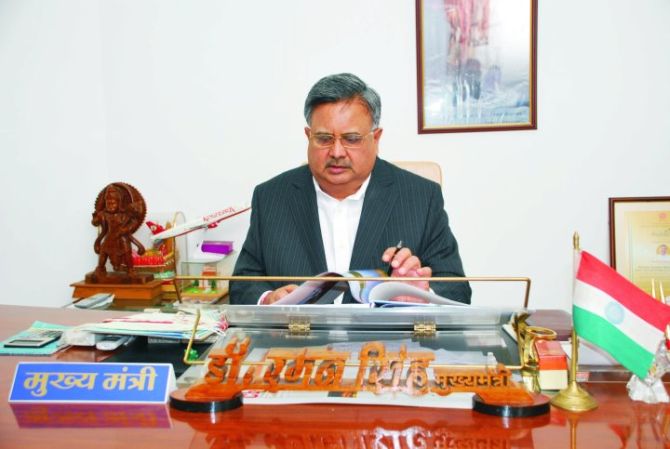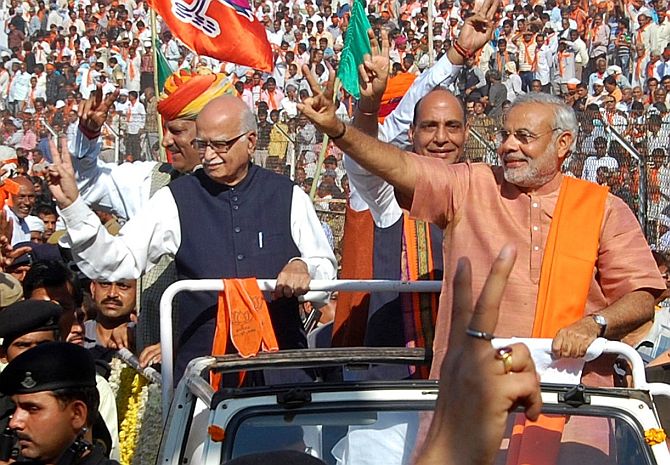 | « Back to article | Print this article |
How BJP built its base in Chhattisgarh
As Chhattisgarh gears up for first phase of elections next week, political analysts are wondering whether incumbent Bharatiya Janata Party Chief Minister Raman Singh can score a hat-trick.
After being carved out of Madhya Pradesh in 2000, the Congress was in office until 2003 when Singh swept to power. This was validated further by re-election in 2008 and strong performances by the BJP in the state in the national elections of 2004 and 2009.
Polls suggest this time around, it is a tight contest and that Singh and the BJP are going to fight hard to win a coveted third term, facing down the usual challenge of anti-incumbency bias. However, the question we really should be asking is, how could the BJP ever have come to power in the first place in a state with the demographic characteristics of Chhattisgarh.
This is a state which has 31.8 per cent of its population being adivasis, one of the highest ratios in the country. Add to that a Dalit population of 11.6 per cent and you get a whopping 43.4 per cent of the population who belong to historically marginalised and under-privileged groups.
A voting block just shy of half of the electorate is sure to be hugely important electorally. Yet, these very groups are the most natural constituency of the Congress or other regional parties and not of the BJP.
Click on NEXT to read further...
How BJP built its base in Chhattisgarh
For good or ill, right or wrong, the BJP is widely seen as a party that speaks for upper caste urban middle class Hindus, appealing to them through the twin planks of economic policies that favour the urban middle classes and course Hindutva.
Neither set of policies would appeal to tribals and Dalits, who would much more naturally be attracted to the Congress party’s combination of policies geared toward redistribution and welfare and which are projected as inclusive of under-privileged groups and minorities.
Yet, the amazing fact is that the BJP has done remarkably well with a constituency you wouldn’t think would want to support them.
According to a survey from the Centre for the Study of Developing Societies, the BJP captured 36 per cent of the tribal vote in the 2003 assembly election, the same as the Congress.
This feat was matched in the 2004 general election, the 2008 assembly election, and the 2009 general election. In fact, in 2009, the BJP actually bested the Congress in terms of winning more tribal voters.
Click on NEXT to read how the BJP managed this remarkable achievement...
How BJP built its base in Chhattisgarh
An important recent research by Tariq Thachil, political science professor at Yale University, has uncovered an important and little understood linkage that helps explain the BJP’s success.
Affiliates of the Sangh Parivar are very active in social work, particularly in the areas of health and education in the state, and this activity, Thachil argues, has helped bridge the political divide between the upper caste-centric BJP and the tribal and Dalit communities.
The two principal Sangh affiliates active in Chhattisgarh are Vanvasi Kalyan Ashram (Association for the Welfare of Tribals or VKA) and Sewa Bharati.
The VKA provides rudimentary health and education services to adivasis in Chhattisgarh villages. Sewa Bharati similarly provides basic social services in the state as elsewhere where they’re active.
Thachil’s qualitative and quantitative research strongly suggests the social services provided by these Sangh affiliates have been crucial in building political support for the BJP in Chhattisgarh especially among adivasis and somewhat less so among Dalits, who’re also being courted by the Bahujan Samaj Party.
Providing basic services to these groups gives the Sangh an entry into these communities at the grassroots level and an opportunity to at least indirectly make the case for the BJP. Sometimes, it can be as simple as earning the trust of local people by providing health and education, where the state has failed to do so.
Other times, it might be more overt and involve recruiting party workers or even candidates as well as more generally broadening the support base for the BJP within these communities.
Ironically enough, the Sangh here has taken a leaf from the work of Christian missionaries in the state, who use the provision of social services as an indirect tool of proselytisation and conversion.
By the same token, the Sangh activists stress to the villages that their primary role is as neutral service providers just trying to help out people in need, not as ideologically driven zealots who want to win them over to their cause.
The statistical analysis reconfirms the qualitative message. Dalits and tribals who came into contact with Sangh social services were 55 per cent more likely to vote for the BJP than those who did not. This helps explain why the BJP has fared so well among these communities in recent elections.
Click on NEXT to read whether this strategy could work elsewhere...
How BJP built its base in Chhattisgarh
In point of fact, the BJP has won 30 per cent or more of the tribal and Dalit vote in the 2004 election in seven major states clustered mostly in central and western India but notably not in sates such as Uttar Pradesh or Bihar.
Thachil reasons that outreach through provision of social services is most likely to work in regions in which marginalised groups are not already politically organised behind parties who represent their interests.
That would explain why the Sangh’s efforts to broaden its support base through social outreach have been markedly unsuccessful in a state like Uttar Pradesh where the BSP is the natural attractor of Dalit votes.
That would also explain why the BJP/Sangh is predictably playing the Hindutva card by again raising the Ayodhya issue. Since they can’t win over a large swathe of voters through good deeds, they have to roll the dice of communal polarisation. But in states like Chhattisgarh in which Dalits and tribals aren’t well-organised politically, the BJP/Sangh strategy could still reap political dividends.
It is no surprise that Raman Singh’s re-election campaign has stressed the state’s generous public distribution system and other welfare programmes. Provision of social services by the state is a natural complement for the private provision of such services by the Sangh.
Win or lose this time around, Chhattisgarh provides important lessons on how religiously-inspired social movements are an important element of the Indian political economy.




